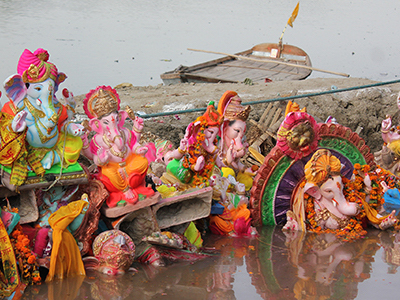NARRATIVES
A SUBLIME UNION
South India
The dancer takes a few steps ahead and pauses, readying herself for the movement. She assumes a posture with her arms raised towards her shoulders, palms closed and thumbs pointed inward, her face a canvas of concentration and devotion. She gracefully stamps her right foot and her left foot in succession and moves her torso downwards. She touches the ground with her fingertips and brings them in contact with her closed eyes. She moves her arms in a circular motion, joining her palms over her head, gradually bringing them down to her chest, as if in prayer. This is the Namaskaram, the obeisance every dancer pays before they begin a performance in the classical south Indian tradition of Bharata Natyam. It is meant to offer the dancer’s respects to the gods, the teachers and the audience whilst humbly asking Mother Earth for permission to stamp on her during the course of her dance.
After each of them performs their Namaskaram and are ready to begin their practice, the dancers form an orderly pattern on the floor and start rehearsing their moves, many of which involve making Mudras - symbolic gestures with their hands and Bhedas - a combination of head, neck and eye movements. The elderly couple at the head of the class looks on in concentration, their palms and feet moving subtly to the rhythms, almost involuntarily. Shanta Dhananjayan and her husband Vannadil Pudiyavettil Dhananjayan, one of the most revered dance couples in India, are hard at work, in the process of passing on their wisdom to younger minds and souls in a class at Bharata Kalanjali, a school for Indian Classical Dance in Chennai.

Established more than forty years ago in a modest house with a thatched roof, Bharata Kalanjali has been forged through the personal philosophies of the Dhananjayans whose values and tradition have trickled down to every aspect of the school’s operations. Students are trained not just in the discipline of dance but in the grand traditions of the art and the beliefs that constitute it so that for them it becomes a way of life and not just something they do a few times every week.
An unspoken grace pervades every moment of the Dhananjayans as they move around the class instructing the dancers, suggesting corrections in shape and posture. A brief conversation with them makes clear the passion they have for their art, a devotional approach that makes you wonder if art is a medium of prayer, a means of communicating with the divine. Steeped in tradition, every element of the environment around us, be it a traditional painting on the wall or a girl draped in a sari with a bhindi on her forehead or an engraving on an earthen flower pot, seems like a reverberation, a call of devotion and spirituality echoing down the centuries.



Bharata Natyam is an art of balance, a sublime union of Lasya, the feminine elements of grace and beauty and Tandava, the masculine elements of energy and force. And the Dhananjayans are a living and breathing example of their art, every move of theirs exuding a sense of togetherness, in thought, spirit and action.

Places Between Pages
I first came across Arundhati Roy’s debut novel “The God of Small Things” as a well-read but little-travelled teenager...
Narrative • South India

Bidding Farewell Elephant Headed God
India’s relationship with its festivals can be addictively joyous, even when it involves bidding farewell to the gods. Every year...
Narrative • North India

In Search of Artisans
Delve into our journey with Hole & Corner across Rajasthan where we explored handicraft and textile traditions in this land of plenty...
Behind-The-Scenes • North India

Kingdoms of Old
This journey traces heritage through the remnants of the dynasties that ruled Madhya Pradesh from ancient times till the present...
Bespoke Journey • West India

Taj Rambagh Palace
Hailed as the stunning ‘Jewel of Jaipur’, the Taj Rambagh is a palace of transitions. It was built...
Hotel Guide • North India

Rising With The Sun in Nimaj
Indians wake up early, often as the sun rises, to pray to the gods for a favourable day and enjoy the few hours where there is no need to hide in the shade...


